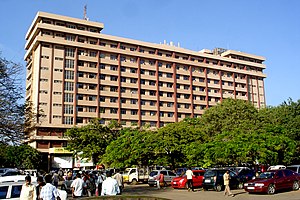Moore Market Complex railway station
Moore Market Complex | |||||
|---|---|---|---|---|---|
 The office complex and entrance of the station | |||||
| General information | |||||
| Location | Station Road, Chennai, Tamil Nadu, India | ||||
| Owned by | Ministry of Railways, Indian Railways | ||||
| Line(s) | North Line, West Line and West North Line | ||||
| Platforms | 5 | ||||
| Tracks | 5 | ||||
| Construction | |||||
| Structure type | Standard on-ground station | ||||
| Parking | Available | ||||
| Accessible | Chennai Central | ||||
| Other information | |||||
| Status | Active | ||||
| Station code | MASS | ||||
| Fare zone | Southern Railways | ||||
| History | |||||
| Electrified | Yes | ||||
| Previous names | Madras and Southern Mahratta Railway | ||||
| Passengers | |||||
| 2020 | 7,00,000 | ||||
| Services | |||||
|
1000 local train services
| |||||
| |||||
The Moore Market Complex, (station code: MASS) or the Chennai Suburban Terminal, is a railway terminus cum commercial building complex for the Chennai Suburban Railway system, situated in Park Town in Chennai, India. The name Moore Market comes from a market that used to exist at the site before its demolition made way for the expansion of the MGR Central station.
History
[edit]
Moore Market was originally built to house the hawkers in the Broadway area of Madras. Its foundation stone was laid by Sir George Moore, president of the Madras Corporation in 1898. The building was designed in the Indo-Saracenic style by R. E. Ellis and was constructed by A. Subramania Aiyar. The market, which consisted of a series of shops around a central quadrangle was finally completed in 1900, and had sections for meat, flowers and food items, but was particularly popular for curios including antiques, art, books and pets. Over the years, it gradually took the status of a flea market where one could buy rare and second-hand items for a bargain.[1][2]
The Indian Railways, needing land to expand the congested M.G.R Chennai Central station, tried unsuccessfully to take over the market. On 30 May 1985, the market building was destroyed due to a fire whose cause remains a mystery.[3] The structure was later razed to make way for the new Chennai Suburban Railway terminus and reservation centre. This multi-storey building also houses the offices of various departments of the railways. The demolition of the market and People's Park is considered to mark the beginning of heritage activism in the city.[1]
Rehabilitation
[edit]The government later built a new commercial complex named Lily Pond Complex to rehabilitate the traders of Moore Market, further west of the original site. Built in 1986 at a cost of ₹ 66 million, the shopping complex lies mostly vacant due to poor patronage.[4] The majority of the traders continue to live on the streets to this day, hawking used mechanical and electronic goods.[citation needed]
Traffic
[edit]The station has five platforms, viz., platform numbers 12, 13, 14, 15 and 16, which are technically continuous with platforms in the M.G.R Chennai Central main railway station. With the laying of two additional lines in September 2016, there are now five lines running between the station and the Basin Bridge railway station. The station caters to about 275 train services daily and is used by about 200,000 passengers every day.[5]
See also
[edit]References
[edit]- ^ a b Sriram, V. (10 October 2008). "To market, to market..." India Today. Chennai: IndiaToday.in. Archived from the original on 16 August 2011. Retrieved 18 November 2012.
- ^ "Gun Street of Chennai". ChennaiBest.com. Archived from the original on 16 March 2015. Retrieved 18 November 2012.
- ^ Buckley, Maureen (8 January 2007). "News: MOORE MARKET". Anglo Indian Portal. Archived from the original on 28 September 2007.
- ^ Krishnan, P.T. "Can we reverse the blight?". Archived from the original on 19 July 2008. Retrieved 9 December 2008.
- ^ "Fate of Royapuram station rests on study". The Hindu. Chennai. 22 August 2013. Archived from the original on 26 August 2013. Retrieved 26 January 2014.

